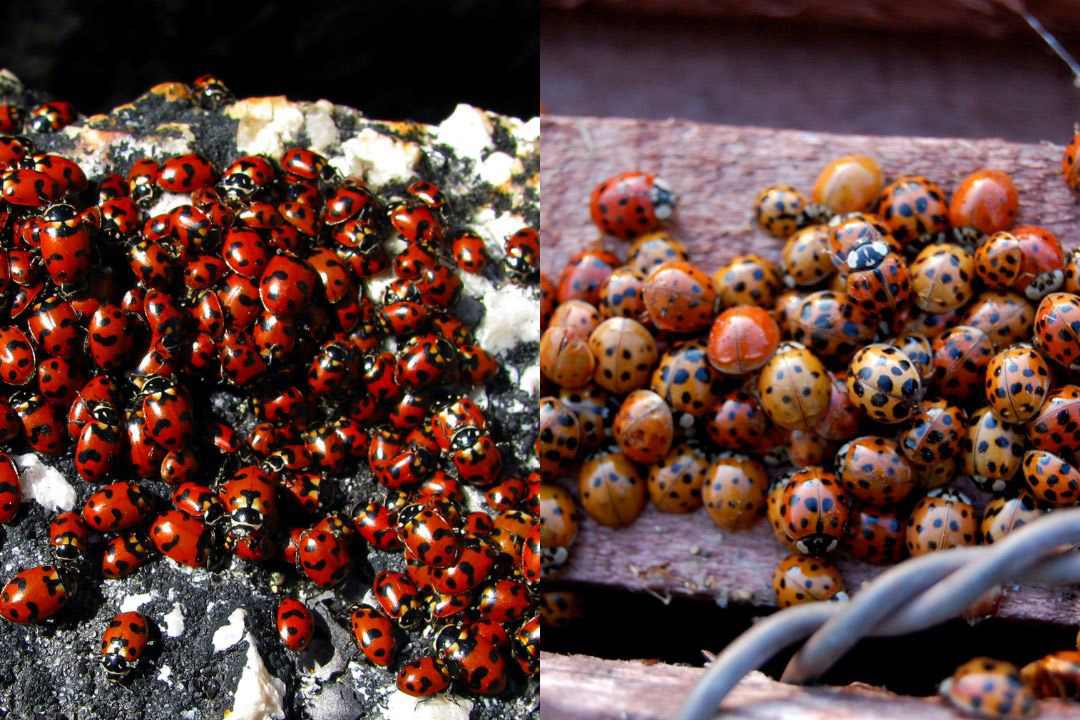Exploring the complexities of using ladybugs as pest control
Assistant professor urges critical thinking when making choices about managing gardens
The convergent ladybug, left, and the harlequin ladybug, right, share many behavioral and life history trains, but one is deemed a weapon in the war on insects and the other the target. RIT assistant professor Kaitlin Stack Whitney uses this example to underscore how human choices are the driving force behind what is considered a pest, not nature. Credit left: Flickr user Dru!, CC BY-NC 2.0. Credit right: Flickr user The Real Estreya, CC BY-NC-SA 2.0
When creating a garden, it’s likely that most people want to make decisions that leave a positive footprint on the local environment. In an attempt to limit the use of chemical pesticides and promote native species on their land, some gardeners have begun purchasing ladybugs as a form of “natural” pest control. However, Kaitlin Stack Whitney, assistant professor in Rochester Institute of Technology’s Department of Science, Technology, and Society, says that buying ladybugs online, as opposed to attracting them naturally, can cause more harm than good to the environment.
In a recent publication in Catalyst Journal, Stack Whitney discussed the morality around employing ladybugs in a war on insect pests, as well as the nuance around which insects are considered “good” or “bad” by the general public.
“Ladybugs make up the insect family Coccinellidae. There are many different kinds of ladybug, but there are a lot of things that all ladybugs do, such as eating soft-bodied insects like aphids and other garden pests,” said Stack Whitney. “How we think about these ladybugs—which ones we celebrate and which ones we don’t—is really shaped by people’s ideas, not necessarily what the ladybugs are actually doing.”
Stack Whitney explains that people likely purchase ladybugs in an effort to aid with ecological restoration in addition to managing pests without using chemical pesticides. But, releasing these insects, rather than employing the myriad ladybugs already in the area, has implications that buyers may not be aware of.
The mail-order-ladybug pipeline is rife with mistreatment of the insect, according to Stack Whitney. Sellers often prey on ladybugs that congregate for winter hibernation. After they’re harvested from the wild, the insects are kept in cold conditions to extend their life cycles until someone decides to purchase them for what she describes as “militarized pest control.” This process is antithetical to the goal of helping the environment.
“Using ladybugs in this way is actually sort of violent. We may want to think that releasing ladybugs is the opposite of spraying chemical pesticides, but it’s just a continuation of this very violent, militarized way of controlling nature around us,” said Stack Whitney. “At the end of the day, if what you care about is promoting predation as a form of pest control, lots of ladybugs and other insects will eat the aphids in your garden.”
Stack Whitney further clarifies that reducing pesticides isn’t a bad approach but that releasing ladybugs is not a “silver bullet” that will fix regional environmental issues. Additionally, she explains that the values placed on various insects— particularly when looking at species that are defined to be native or non-native to an area— have historically been rooted in xenophobia, racism, and misogyny.
“It’s so important to understand how issues of gender and race show up in how we think about the world. When we hold native species to be a stand-in for good or virtuous, it’s a choice that’s really based on what we’ve decided is the best,” said Stack Whitney. “Every type of environmental management is a set of choices in which you are preferring one species over another. A classic example of this that I share with my students is to ask, ‘if we truly value all forms of life, who is going to help conserve parasites?’”
Humans have been manipulating and influencing the environment for centuries, but people being mindful of the choices they make when managing their gardens and enjoying the outdoors can make all the difference. Instead of purchasing mail-order insects for pest control, Stack Whitney suggests exploring alternative methods such as cultivating plants and pollinator-friendly flowers in the garden to naturally attract them.
“One of the challenges of teaching about the environment is often times people think that it’s all doom and gloom. But the historical ideas that have shaped the environment, ideas that can sometimes feel really heavy and daunting, were the results of a set of choices. Understanding our past choices means we can make different choices going forward to craft a better future.”












